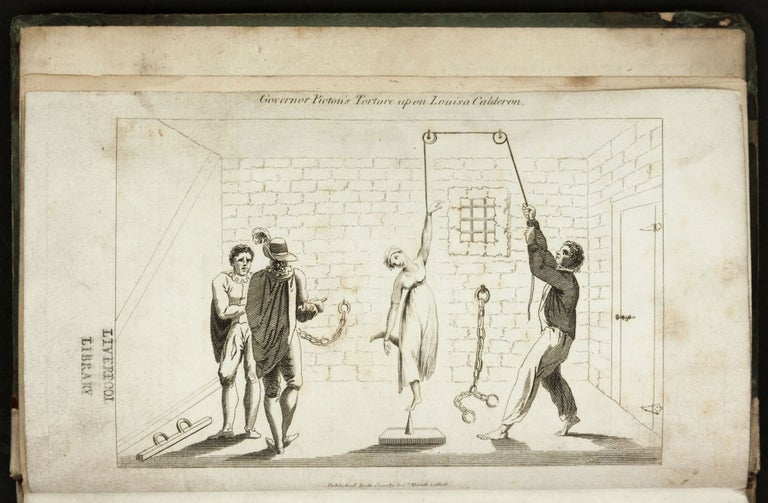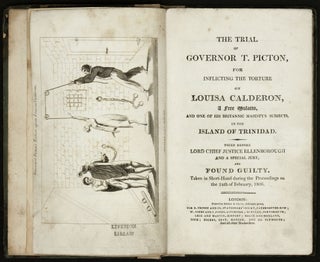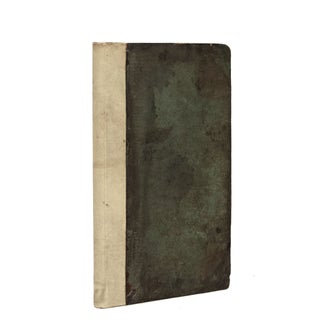The Trial of Governor T. Picton, for Inflicting the Torture on Louisa Calderon, A Free Mulatto, and one of His Britannic Majesty’s Subjects, in the Island of Trinidad. Tried before Lord Chief Justice Ellenborough and a Special Jury, and Found Guilty.
4to [21.4 x 13.0 cm], 126 pp., the first leaf is a full-page engraving. Bound in contemporary green boards with later white card spine. Some staining and edge wear to boards. Occasional mostly minor foxing and staining, very short (1 cm) tear to blank margin of engraving, small stamp of the ‘Liverpool Library’ in blank margin of engraving, the occasional contemporary annotation. Very rare first edition of the authoritative eyewitness account of one of the great legal (and media) sensations of the British Empire during the early 19th century, the infamous 1806 trial of Thomas Picton (1758-1815), former Governor of Trinidad, who was accused of illegally ordering the torture in 1801 of Luisa Calderón, a thirteen-year-old free mulatto woman suspected of being an accessory to burglary. The method of torture used in an attempt to extract a confession from Calderón was known as “picketing” (the British public would come to call it “Picton-ing”) and is here illustrated in a striking full-page engraving, an image which takes its place among the more disturbing visualizations of torture from the colonial Americas. After just one day of arguments and only five minutes of deliberation, the jury found Picton guilty. The trial divided public opinion, raising questions about the application of law in British territories and exposing uncomfortable truths about race, sexuality, violence and national security in the empire during an era of revolution and war. This complete transcript of the trial is based on notes “Taken in Short-Hand during the Proceedings” and was considered in its time be the definitive firsthand account of the proceedings, a distinction which is supported by historians to the present day. Calderón testified of her torture that, “one wrist was tied up to a pully at the ceiling, and the toe of one foot was on a spike of wood. The other hand and foot were tied together” (p. 16). The transcript relates that, “a drawing in water colours was handed to her representing in a striking manner her situation with the executioner and attendants during this torture,” and that she next was asked to describe the fetters or grillos she was bound with between torture sessions: “The councel for the prosecution produced a drawing in ink of this machine, which the witness said was a just representation of it” (p. 18). Several depictions of Calderón’s torture circulated at the time, but most of these are rather sensationalized, while the engraving in the present trial transcript closely follows the torture as described in the testimony (the grillos can be seen in the corner of the cell), suggesting that this image was perhaps derived from the very prop used during the legal proceedings. Calderón recalled that she had seen others tortured in the same manner, while a witness to Calderón’s ordeal, a certain Rafael Shando, testified about another instance of torture carried out at Picton’s command: “I recollect General Picton once said to the gaoler, ‘Go and fetch the black man of the picket guard, and put him to torture.’ This was the first instance of the use of torture in Trinidad, that I was acquainted with” (p. 27). It became clear that the outcome of the trial hinged on whether Picton broke Spanish law, the code a colonial governor was obliged to follow when administering Trinidad. The defense argued that judicial torture was a common and accepted legal practice in the Spanish West Indies, but the defense fell apart when it became clear that not a single instance of lawful torture was mentioned in Spanish legal texts of the time, and that while torture might have been practiced in Spanish Trinidad, it was not sanctioned by any laws. Even before the incident involving Luisa Calderón, numerous reports of Picton’s bad governance in Trindad had reached London. In 1803, Picton was arrested on the orders of the Privy Council on charges that included being responsible for the “unlawful deaths” of slaves, free people of color and even some of his own soldiers. For reasons that are not entirely clear, the Privy Council elected to deal with almost all the charges behind closed doors. Picton immediately appealed his conviction for the torture of Luisa Calderón and at a retrial in 1808 the conviction was overturned based on a new examination of Spanish legal precedents, but the jury asked for the court to consider that torture of a free person was so repugnant to the laws of England that Picton must have known he could not permit it, no matter what Spanish law authorized. Picton would become known for his exploits under Wellington in the Iberian Peninsular War of 1807-14; he was killed in 1815 fighting at the Battle of Waterloo. Calderón returned to Trinidad following the 1808 trial and nothing more is known about her fate. * Sabin, no. 62684; S. R. Cudjoe, Beyond Boundaries: The Intellectual Tradition of Trinidad and Tobago in the Nineteenth Century, pp. 7-21; J. Epstein, “Politics of Colonial Sensation: The Trial of Thomas Picton and the Cause of Louisa Calderon,” The American Historical Review, vol. 112, no. 3 (2007), pp. 712-41; J. Epstein, ‘“The Shrug of Horror”: Creole Performance at King’s Bench’, in V. Agnew and J. Lamb, eds., Settler and Creole Reenactment, pp. 94-106; J. Peake, Between the Bocas: A Literary Geography of Western Trinidad, pp. 52-56.
Sold



